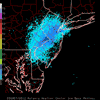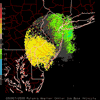Last night saw a noticeable but less eventful movement of birds than the past few nights. This is consistent with what we usually see during migration; where during consecutive days of movement numbers peak in the first couple of nights, and then taper off as the number of birds fit to migrate decreases over time. When the next frontal system passes, conditions again become optimal for nocturnal migration, and those birds that had not been fit during the last movement will more likely be fit enough to move on, and so goes the cycle of migration.
Something to note (and hopefully not confuse). If you look at both loops simultaneously you’ll notice that in some cases where there is a signal in the reflectivity loop (the mostly blue one), you’ll also notice that the corresponding area in the velocity loop is colored gray. This indicates that the signal that is present there is not moving (has no velocity). In this case, what we’re seeing is called anomalous propagation, and is caused by a temperature inversion after sunset. Therefore, if you (mentally, of course) ‘subtract’ all the area that has no velocity from the reflectivity loop, you’ll have a better idea of the actual amount of bird migration taking place.

